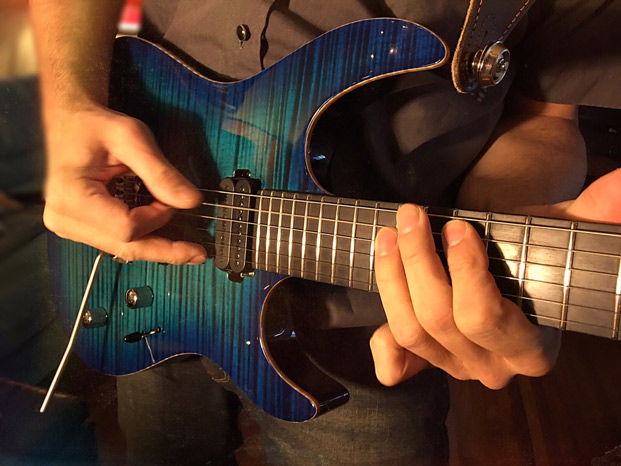Using Tapping to Extend Sweep Arpeggios

In the last three columns, I demonstrated the mechanics of my technique for sweep picking arpeggios and some of my go-to shapes.
This month, I’d like to show you a great way to expand upon these shapes, by adding a fretboard tap above the highest note played in the sweep. There are different technical approaches to tapping: there’s the “Van Halen” method, wherein you clasp the pick between your thumb and middle finger and use the index finger to tap; I prefer to hold the pick conventionally—between my thumb and index finger—and use my middle finger for tapping.
FIGURE 1 depicts an Am arpeggio played in 12th position, starting on the fifth string and moving across the top five strings to the high E. The first note, A, is fretted with the index finger at the 12th fret, after which I hammer-on with my pinkie up to C at the 15th fret. I use a downstroke to sound the subsequent notes up to the high E on the first string’s 12th fret, after which I hammer-on with my pinkie up to the 17th fret.
On the downbeat of beat two, I tap a high C note at the 20th fret on that same string and then perform a double pull-off back down to the A and E notes, followed by an upstroke sweep that moves back down across the top five strings. The figure then repeats. We can also add a high tap to other, lower Am sweep arpeggio shapes, as demonstrated in FIGURES 2 and 3: individual notes are sounded on each of the five highest strings until I reach the high E, at which point I hammer-on from C up to E then apply a tap on the high A root note at the 17th fret. In FIGURE 3, as in FIGURE 1, the tap occurs right on beat two.
Back in the early Eighties, when many of these rock guitar playing techniques were first being explored, a slick tapping technique became popular that involved sliding a tapped note up and down before pulling back off to a lower note. I like to refer to this technique as the “MI sweep,” in reference to Musician’s Institute in Los Angeles, the guitar school where many great players either attended or taught.
As demonstrated in FIGURES 4–6, I tap at a given fret and then slide up one or two frets and back before pulling-off from the tap and moving back down through the sweep arpeggio.
When pulling off from a tapped note, you’ll want to flick the string slightly sideways to keep the string vibrating and the notes ringing with sufficient volume. This may be accomplished by flicking the string either upward (toward the sky) or downward (toward the ground). This technique also works well with major arpeggios: FIGURES 7–9 illustrate taps and sliding taps within major triad shapes on different areas of the fretboard. Be sure to play through each figure slowly at first and strive to sound each note clearly and evenly.


Get The Pick Newsletter
All the latest guitar news, interviews, lessons, reviews, deals and more, direct to your inbox!










